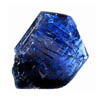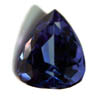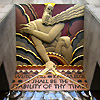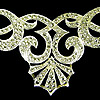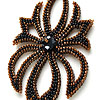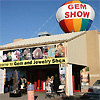December, 2011

Happy Holiday Season!The holiday season is for family gatherings, fattening goodies, and flickering lights. We love you all and wish you success and best of luck, and happiness in 2012! Have a rest and enjoy your reading, in the final December issue of our 2011 year newsletter:
Tanzanite - blue Zoisite
Contact us with any questions at
info@mylovelybeads.com.
Fashion Colorworks 2012. Jurors Art Deco style and jewelry Extending framework of techniques Step by step - Beaded handbag January upcoming events Best regards, MyLovelyBeads.com Team
|
|
|
|
Tanzanite - blue ZoisiteIn 2002 the American National Association of Jewelers officially adopted tanzanite as a December birthstone. Tanzanite is the blue/purple variety of the mineral zoisite which was discovered in the Mererani Hills of Northern Tanzania in 1967, near the city of Arusha and Mount Kilimanjaro. Tanzanite is noted for its remarkably strong trichroism, appearing alternately sapphire blue, violet and burgundy depending on crystal orientation. Tanzanite can also appear differently when viewed under alternate lighting conditions. The blues appear more evident when subjected to fluorescent light and the violet hues can be seen readily when viewed under incandescent illumination. Tanzanite in its rough state is usually a reddish brown color. It requires artificial heat treatment to 600 grades of Centigrade to bring out the blue violet of the stone. Tanzanite is a rare gem. It is found mostly in the foothills of Mount Kilimanjaro. The mineral is named after Tanzania, the country in which it was discovered. Officially called "blue zoisite" it was marketed as tanzanite by Tiffany & Co., who wanted to capitalize on the rarity of the gem, then only found in Tanzania. From 1967 to 1972, an estimated two million carats of tanzanite were mined in Tanzania before the mines were nationalized by the Tanzanian government. The world's largest faceted tanzanite is 737.81 carats. One of the most famous large tanzanites (242 carats) is the "Queen of Kilimanjaro". It is set in a tiara and accented with 803 brilliant cut tsavorite garnets and 913 brilliant cut diamonds. Because tanzanite is relatively soft, it is usually set in necklaces and earrings, so the tiara is truly a rarity. The tiara is currently on display in the Gallery of Gold and Gems at the Royal Ontario Museum in Toronto, Ontario, Canada. The exhibition is from the private collection of Michael Scott, the first CEO of Apple Computers. |
|
Fashion Colorworks 2012. Jurors
Marcia Jestaedt. Marcia Jestaedt lives in Bowie, Maryland. She is a ceramic artist whose tile work consists mainly of orientally inspired robes. She feels that design and color are basic to all forms of art and that critical choices of both determine its success or failure. She has been dealing with these elements for over 35 years and continues to love the challenge that they present. She spends many months drawing her designs and choosing the colors that she thinks will make the piece successful. The latter is very important as once the piece is fired changes in color cannot be made. She is a graduate of the University of Maryland having majored in studio arts. She has taught both privately and at various educational venues including the University of Maryland. She has received many awards and grants, and her work has been exhibited and is in collections throughout the USA, Europe, Africa and Asia. Website: www.marciajestaedt.com 
Patrizia Tager. Patrizia Tager was born in Italy where she lived till the age of 12. At the age of 12 her family moved to London (UK) where she attended school and college. She graduated with a B.A. Hons. in Fashion Design. After college Patrizia moved to Israel, where she resides today. Her interest in beadwork was ignited after attending basic beadweaving classes at a local bead shop. From that point on she set out to learn as many beadwork techniques as she could find. She fell in love with bead embroidery and throughout the years developed her jewelry designs to incorporate bead embroidery with different bead weaving techniques. Her designs are contemporary using old traditional techniques. Her work has been published in "Flatwork" by Nicole Campanella and in Issue 23, January 2011 of "Making Jewellery".
Blog: triz-beadingmania.blogspot.com

Birgit Bergemann. Birgit Bergemann is from Biesenthal, Brandenburg, Germany. She always loved to be creative, and she has knitted and crocheted. In 2003 Birgit learned beads, started beading and soon turned that from a hobby to a profession. In 2007 when she lost her job she decided to open a bead shop. Her great advantage was that Birgit already knew a lot about beads, their shapes and how to use them best of all, and how to work with them. She also believed that she was given a good feeling for colors and what to advise to customers. Birgit's motto is to advise her customers in such a way that they benefit from it. Twice Birgit has entered bead contests from I-Perlen and won first and second prizes. Since the beginning she has been a member and an administrator of the German bead forum, www.perlenhaekeln.de; and since 2009 a staff member of the German Perlen Poesie magazine.
Blog: fofinhas-perlenstuebchen.over-blog.de

Maiko Kage Felton. Maiko lives in Irvine, California, USA, but she kept close relationship with her native country Japan, she has experienced much success as a bead designer in Japan. She started her career nearly a decade ago when she happened upon some American beading magazines. Impressed by the beauty of the pieces profiled in the magazines, Maiko set out to master various beading techniques. Her pieces tend to explore the interplay between symmetry and nature. In the studio Maiko prefers to let her creativity flow freely; this allows the piece to define itself during its creation. She has been a finalist in the Bead Dreams contest in 2005, 2006, 2007 and 2008. Her work has also placed in the Bead Arts Awards in 2005 and 2006. Maiko has published two beading books in Japan. She routinely conducts beading seminars throughout Japan and has had her tutorials appear in Bead & Button Magazine. Website: www.happybeading.net 
Albina Polyanskaya. Albina Polyanskaya is one of the most talented professional beaded jewelry designers we have come across. She has been creating jewelry for much of her life. Albina, who lives in Kharkov, North-East of Ukraine, has said that jewelry design is her way to express herself. For many years she has developed her skills in beading techniques learning peyote stitch, square stitch, cross stitch, etc. Albina likes working with beads and gemstones, pearls and shells, creating impressive free-from designs. She is a very cheerful and life-loving person and feels that surroundings are great influencers our emotions and behavior. She is a winner of many local and international jewelry design contests, a permanent participant of bead exhibitions. Albina is also an experienced teacher and a writer: last year Albina published a book "Beadwork: 100 patterns" (in Russian). Website: www.beads.com.ua 
Peter Sewell. Peter Sewell, bead artist and beadweaving teacher, lives in Wakefield, West Yorkshire, England. He made his first beadwoven square in December 2007, then set out to learn as many beading stitches as he could find, keeping the one's he liked, and filing the one's he didn't. Three months later Peter made his first real piece, a netted Egyptian collar from a design by Varvara Konstantinov. This attracted him to the historic style of Imperial Russia and Eastern Europe, which seemed to suit his need for technicality and precision in design. Peter's designs have recently been called "bead engineering", and he likes that label, it is very close to how Peter sees his work. Peter's Sonya Necklace is gracing the front cover of the Oct/Nov 2010 issue of Beadwork Magazine, Adele Necklace is featured in the December issue of the German Perlen Poesie Magazine.
Blog: petersewell.blogspot.com
|
|
Art Deco style and jewelryFrom April 15 to November 12, 1900 the Exposition Universelle, a world's fair took place in Paris to celebrate the achievements of the past century and to accelerate development into the next. The style that was universally present in the Exposition was Art Nouveau. Though Art Nouveau art and architecture has flourished at that time, some French artists organized a formal collective known as La Societe des artistes decorateurs (the society of the decorator artists). Founders included Hector Guimard, Eugene Grasset, Raoul Lachenal, Paul Follot, Maurice Dufrene, and Emile Decour. These artists heavily influenced the principles of Art Deco as a whole. This society's purpose was to demonstrate French decorative art's leading position and evolution internationally. In 1925 they organized Exposition Internationale des Arts Decoratifs et Industriels Modernes (International Exposition of Modern Industrial and Decorative Art), which would feature French art and business interests. Art Deco was developed in direct contrast to the preceding Art Nouveau era and was most prominent between World War I and World War II, during the 1920s and 1930s. The initial movement was called Style Moderne. The term Art Deco was derived from the Exposition of 1925, though it was not until the late 1960s that this term was coined by art historian Bevis Hillier, and popularized by his 1968 book "Art Deco of the 20s and 30s". In the summer of 1969, Hillier conceived organizing an exhibition called Art Deco at the Minneapolis Institute of Arts, which took place from July to September 1971. After this event, interest in Art Deco peaked with the publication of Hillier's 1971 book The World of Art Deco, a record of the exhibition. The Art Deco art movement and style had a lot influence in the world of jewelry. Females of this time period began demonstrating their new equality by baring arms, painting lips, bobbing hair and wearing short dresses in the scandalous "flapper" style. This new, boyish silhouette was accessorized with Art Deco jewelry, which consisted of long dangling necklaces and earrings, bold rings and multiple bracelets. Art Deco jewelry designs were influenced by Egyptian, African and Oriental themes. The integration of mysterious Chinese and Indian style and orient elements of Japanese art make Art Deco jewelry occupied with mysterious charm. It used its creative design to perpetually mark down exotic culture. All the treasure with mysterious orient features uniquely deduced the orient culture. Since the tomb of Tutankhamun was found in 1922 by archaeologist, a new trend of Egyptian decoration swept across the jewelry fashion by creative inspiration. Common Art Deco jewelry motifs included cute animals, silly fruit, fast cars and sparkling flowers in every imaginable color. Scarabs and sphinx elements are inspired by the Egyptian influences. Transportation symbols, such as planes, cars and even fast animals like panthers became a recurring theme in Art Deco jewelry design. At the early twenty century, Russian Ballet and American Jazz had a great and meaningful effect, designers integrated the unique charm of stage art into the design of jewelry; the jewelry styles also reflected the playful, flamboyant attitude of Hollywood. |
|
Extending framework of techniques
We are glad to introduce you a young bead artist from Belorussia, Olga Arsentieva. She is only 32, but she made a great success. Her intricate lacy beadworks make people admire her jewelry and make them think about beadwork as of true art. Olga says, "I've been searching for myself for all my life, for 32 years. I live in the city of Minsk, Belorussia, that is the place where my family is and where I can speak the native language, although I can understand a few more. If you'd like to know what I do, in past, I'm an economist, market analyst with major in international transportation. In the last period, I'm in the field of creativity and art. I can comply with requirements and be even higher than people's expectations, but whether it can bring harmony to the soul and happiness? I'm not sure. Something that we want to do we understand being a child. Often it's intuitive and illegible feeling. Since my childhood, I've known that I was interested in creating something with my hands, but what? I was fond of everything: scrapbooking, knitting, embroidery, macrame, sculpture, drawing... All, perhaps, is impossible to enumerate. Also, I liked music and studied in a special school. Music fascinated me truly, deeply and passionately, but my fate turned quite differently. I studied at university, worked, noted my career and non-career achievements, trying to find some time for creativity, but gradually imbalance grew up. I got married, then my son was born, and at that time, oddly enough, I had more time for my hobbies. It so happened that one of them received an impetus to development. Once a relative of mine came to me and pulled out a forgotten and tiny bag with beads, and at this point as if something clicked inside me. I always loved the jewelry in my childhood and I had a box with my "treasures", my mother's friends has given to me broken jewelry, and I carefully folded it into my trunk. Thus, beading meant two interesting things for me: the opportunity to create with my own hands and to make jewelry! Beads are surprisingly flexible material, it reminds me of sand, from which, like a sculptor, you can "sculpt" simple things and create masterpieces. For the latter, of course, it is not enough to learn basic techniques, to watch beadworks on the Internet and to read the random literature. You require knowledge in the field of color, composition, and even useful to know the rules of perception and human information processing."
Full article by Olga Arsentieva
|
|
Step by step - Beaded handbag
This tutorial is not about handbags bead embroidery that can be done many ways. The final touch if creating handbags is setup of its frame. A year ago we wrote about Olga Orlova, an artist of bead and golden needle sewing. Olga was so kind and prepared for us a tutorial on setting handbag frames, she is a guru in that field. We hope the tutorial in pictures would be useful for you if you want to make beaded purses.
|
|
Upcoming events
January 27 - February 7, 2012 Tucson Gem & Jewelry Show is the largest and most popular independent jewelry trade show in the Tucson, Arizona area. Wholesale jewelry manufacturers, miners and international dealers gather in Tucson every winter.
January 27, 28, 29, 2012 Juried Fine Art & Craft Festivals since 1976. Find the unique handcrafted artwork of thousands of American Artists! Decorative creations for home & garden, exceptional fine art & designer crafts! |
|
Note
If you don't see the newsletter properly formatted please click here:
December Issue
|
© 2011 MyLovelyBeads.com All Rights Reserved.
If you do not want receive our newsletter and you wish to remove your email address from our mailing list, please click the following link to unsubscribe.



